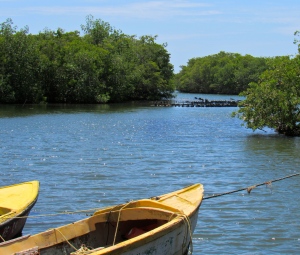This is the second part of my recent “day trip” with Ingrid Parchment, Executive Director of the Caribbean Coastal Area Management Foundation (C-CAM), across the Portland Bight Protected Area (PBPA). May I remind you, first of all, that the PBPA is Jamaica’s largest protected area, comprising 1,876 sq km of coastal land and sea, and cays such as Little Goat Island. The PBPA is home to birds, iguanas, crocodiles, manatees, marine turtles, and fish, many of which are endemic to the area. In 2010, the Ministry of Agriculture and Fisheries gave C-CAM the mandate of managing three fish sanctuaries – but with limited resources.
We left Old Harbour Bay, and drove along the coast, a little further inland, along the dry and dusty Salt River Road. We drove around Freetown, past Longville Park, then through the district of Cockpit (not to be confused with Cockpit Country, of course – perhaps named for cock-fighting that took place there) and noticed white scars on the low, green hillsides from a limestone quarry.
If anywhere in Jamaica is indicative of the impact of climate change on the landscape, the parish of Clarendon is probably right up there. Always one of the drier parishes, Clarendon has suffered from extraordinarily low rainfall levels in the past year or two; this summer, according to the Meteorological Office of Jamaica, it has received around nine per cent of its normal 30-year cycle. El Niño is likely to continue at least until the end of the year. The rivers are dry. Serious beach erosion is another huge problem, all along the south coast. This part of the PBPA also suffered considerable damage during the Category Four Hurricane Ivan, which arrived on September 11, 2004, and has struggled to recover. As a part of an adaptation strategy, C-CAM and its partners plan to develop community-based tourism as an alternative to traditional livelihoods that are struggling.

We stopped at a refreshing spot along the road – a mineral spring, at the side of the river. The water was clear as a looking glass, and a couple were enjoying a dip. We turned off and came to a beach that Ingrid called “Welcome Beach,” right where the Salt River moves slowly to the sea. It’s a “local beach,” where residents come to relax, get a little sea air, splash in the water. It was sad to see, however, that it was submerged with piles of seaweed; the landscape had changed. Clouds of seaweed floated in the water, ready to add to the piles. I spotted two Ruddy Turnstones, busy feeding in the seaweed.

An important part of C-CAM’s work, as I have noted before, is community outreach. As we know, sargassum seaweed has become a problem right across the Caribbean, from east to west; Ingrid noted that the loss of the beach would have a negative impact on the lives of local people who used to enjoy it. “Livelihood is about more than earning money,” she pointed out. “It’s about peace of mind, the quality of your life.” This is just as important for rural residents as for city dwellers.


Just a short distance away, however, a man and two children, visiting from overseas, were enjoying themselves by the side of the Salt River. I spent a lot of time scanning the water for crocodiles, but did not see any. Not this time. I did photograph some Common Gallinules, looking as usual like small toys on the water. Turning back up the river, we stopped at a fishing boat post. There lay in the water the skeletons of sugar barges, left where they were last moored perhaps a hundred years ago, rotting and silent. I was irritated to find that the fishermen just threw their old oil containers and water bottles down on the edge of the water. Why couldn’t they keep this small area clean? “Nuh Dutty Up Jamaica!”

The next stop was at C-CAM’s Field Office on Salt River, situated on land belonging to the Monymusk Gun Rod and Tiller Club. As we arrived, a family was about to go out for a fishing trip. If this sounds a little odd, I should explain that C-CAM works hard to maintain healthy and co-operative relationships with all stakeholders in the PBPA – and that includes bird shooters and sports fishers, who also have an interest in environmental sustainability. It’s all “a question of balance,” as they say.

Field officers work hard, monitoring the area on a daily basis and collecting data on the fish – checking and moving fish pots around, measuring and weighing the fish and returning them to the water. I attended the opening of the Field Office, which received support from the Ministry of Agriculture and Fisheries, the California-based NGO Seacology and the local bauxite company WINDALCO.
We moved on to another very important site: C-CAM’s Wetland Interpretive Centre, which had a soft launch recently. And that is for Part Three of this account… Stay tuned!
For more information on the work of the Caribbean Coastal Area Management Foundation (C-CAM) in the PBPA, please visit their website at http://www.ccam.org.jm. You can also find them on Facebook and on Twitter @ccamfngo. You can also visit my Flickr account (Bananakatie) for photographs of the opening of the Field Office in August 2013, which I attended, here: http://flickriver-lb-1710691658.us-east-1.elb.amazonaws.com/photos/bananakatie/sets/72157629863199887/

I am so glad this happened, and I knew the C-CAM people would be great! We are really looking forward to seeing the finished product. Sustainable development is not an easy road to travel, but we must… 🙂 Thank you so much for introducing your readers to my blog (which reminds me – there is a “Part 3” to this series, which I have still not yet written, about the Wetlands Interpretive Centre! Our fishermen are so important…
LikeLike